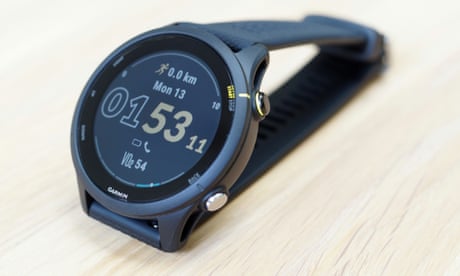- by foxnews
- 08 Apr 2025
Garmin Forerunner 255 review: runner’s best friend gets GPS and multisport upgrade
Garmin Forerunner 255 review: runner’s best friend gets GPS and multisport upgrade
- by theguardian
- 12 Jul 2022
- in technology

Garmin's latest running watch has been upgraded in almost every way, bringing multisport tracking, more advanced GPS and a bunch of high-end features down to a more affordable price with the Forerunner 255.
The longstanding series is available in two sizes for the first time with the 255 - a small 41mm-wide case and a larger 46mm model, which means it should fit comfortably on a wider range of runners' wrists. But it has very big shoes to fill, replacing the well-regarded Forerunner 245 from 2019.
Both sizes of watch have the same RRP. It is �300 ($350/A$629) for the standard model or �350 ($400/A$699) for a version capable of storing and playing music to Bluetooth headphones from Spotify and others without the need for a phone.
The new watch has a sleeker design, more like 2020's Forerunner 745 than the Forerunner 245. The sharper colour transflective LCD display is super clear in daylight with a backlight for night-time use but it doesn't have a touchscreen, instead relying on five buttons for navigating the interface, which work well for exercise, even in adverse weather.
The watch is snappier than its predecessor, too, making syncing and switching between data screens, activities and watch faces much faster. The watch is thin enough to fit under shirt cuffs while being light and very comfortable to wear all day and night for weeks without charge.
The 255 can be used independently of a phone but works best paired with an Android or iPhone via Bluetooth, which enables the syncing of your data to Garmin Connect and various smartwatch features such as call or message notifications.
Alternatively, you can sync via USB cable to a PC or Mac or via wifi straight to the cloud on music-supporting models.
The battery life is great. The 46mm version lasts about 14 days as a smartwatch with notifications, general heath tracking, including sleep, and more than three hours of activity tracking. That's double the life of the Forerunner 245.
The watch will last a good 16 hours of running with the most accurate location tracking mode active or up to seven hours while also listening to music. Switch to the more efficient GPS-only mode and it will last up to 30 hours of tracking. The smaller version lasts slightly less but both models can handle a marathon or even two depending on how fast you are.
The new watch supports Garmin Pay, which is useful if you need to buy a drink or unexpectedly get the bus home while on a run, but few mainstream banks are supported in the UK.
The Forerunner 255 is generally repairable. The battery is rated to last at least a few years of frequent charge cycles while maintaining at least 80% capacity. The watch does not contain any recycled materials. Garmin guarantees at least two years of security updates from release but typically supports its devices far longer. It offers trade-in schemes for some lines and complies with WEEE and other local electronics recycling laws.
The 255 builds on the excellent sport tracking capability of its predecessor, adding lots of new features and capabilities inherited from Garmin's more expensive models. It has the firm's new 4th-gen heart rate sensor, a barometer and compass, and the next-generation "multiband GPS". This increases tracking accuracy and reliability around tall buildings or vegetation by locking on to newer frequencies from GPS satellites.
It has plenty of useful features without being overloaded with gimmicks. The watch consistently gets a GPS lock within seconds - much faster than its predecessor - and produces more accurate live pace estimations when running. It records practically every metric you can think of allowing you to track or train by a wide variety of different methods including heart rate zones and power, although you'll need a compatible foot pod or chest strap for running power (sold separately for a range of prices). It has the stamina feature introduced with the high-end Fenix 7, too, which is a useful live estimate of how much energy your body has left during a run.
The other big upgrade is multisport tracking, such as for triathlons, a feature previously reserved for Garmin's top models. It will track more than 30 different activities, including a collection of workouts across strength and cardio, multiple forms of cycling and swimming, and can combine them into one seamless event.
Garmin has also beefed up its automated coaching system - free - which can now create a fully structured and adaptive training plan for races, including the buildup and tapering to help you perform your best on the day. It is currently designed for running, not cycling or multisport, but it is very impressive - few companies offer this level of personalised training plan, let alone one that adapts in real time to your progress.
The 255 has a solid set of general health-tracking features, too. Automatic sleep tracking feeds into Garmin's excellent body battery, which makes it easy to understand the impact of sleep, activity and rest on your day.
It has stress tracking, all day heartbeat monitoring , the standard calories, steps, stairs and sedentary alerts, blood oxygen tracking and other metrics. Plus Vo2 Max fitness measurement, a standard cardiac measurement, and a tool estimating your recovery time after exercise. Overnight heart rate variability is a new metric, which takes three weeks to calibrate to your baseline and can then can be used to highlight over training, stress, illness and other factors.
The Garmin Forerunner 255 comes in two sizes (41mm or 46mm) and costs �299.99 ($349.99/A$629) or �349.99 ($399.99/A$699) with offline music playback.
For comparison, the Forerunner 55 costs �149.99, the Instinct 2 costs �299.99, the Forerunner 955 costs �479.99, the Fenix 7 costs �599.99. The Coros Pace 2 costs �180 and the Polar Vantage V2 costs �343.20.
The new Forerunner 255 takes everything that was good about its excellent predecessor and turns it up to 11.
The faster interface, longer 14-day battery life and option of different sizes for a better fit are very welcome. It is thin, light and comfortable to wear. It ticks almost every box for general health tracking, handles basic smartwatch functions and the top model supports offline music from Spotify and others.
Garmin's Connect app is the best in the business and provides easy syncing to Strava and other popular services. And the watch tracks almost every metric you can think of making it easy to see what is important for your training plan.
The next-gen GPS upgrade and addition of true multisport tracking for triathlons and other events brings useful high-end features to a more palatable price. The new automatic race coach looks like it will be extremely useful tool, too.
The only thing missing is onboard maps for route guidance if you get lost, which is still the reserve of more expensive models.
The Forerunner 255 isn't the cheapest on the market but it is the best. If you don't need offline maps and routing, this running and multisport Garmin should be at the top of your list.
- by foxnews
- descember 09, 2016
Ancient settlement reveals remains of 1,800-year-old dog, baffling experts: 'Preserved quite well'
Archaeologists have recently unearthed the remarkably well-preserved remains of a dog from ancient Rome, shedding light on the widespread practice of ritual sacrifice in antiquity.
read more





